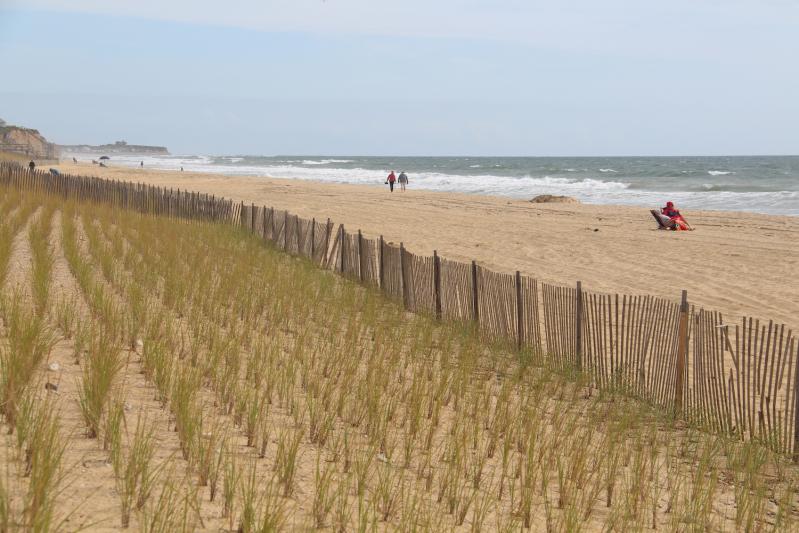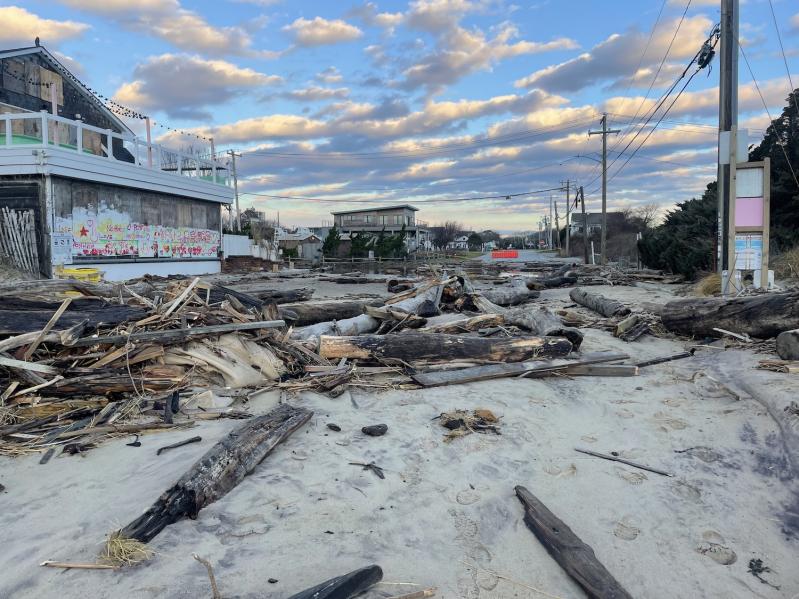It was a Thursday afternoon when the big one hit. Until the night before, the storm had been forecast to slide just around Montauk, a narrow miss. Few had wanted to leave their homes and businesses on what they saw as a half-baked prophecy. So when the hurricane trained its eye on Montauk, there was nothing to do but hunker down and wait. For the next 20 hours, Montauk would be a ghost town. The winds grew violent, the ocean rose up, and Montauk prayed it was ready for the hell Mother Nature was about to unleash.
Cans of vegetables and loaves of bread floated through the aisles of the Montauk I.G.A., just a block from the oceanfront. A man stood in water up to his knees as his 4-year-old granddaughter clung to him. Fishermen were regretting their decisions to shelter on their boats, knowing it was too late. The Napeague stretch was six feet underwater. Downtown Montauk was drowning and the harbor had been destroyed. Boats were capsized and piers had been smashed to pieces. Power was out and cell towers were down. The worst of the storm had come and gone, but the disaster was far from over.
That’s an imaginary scenario, but eventually, a major hurricane is coming, and Montauk — whose lifeblood is the ocean — is not ready. If the hamlet is hit by a truly big hurricane, it won’t be able to just get back to its feet and walk on. To make even a dent in the task of full recovery will require an army of dedicated experts, officials, and residents — and a yacht-load of money.
This year, the National Oceanic and Atmospheric Administration predicted an 85 percent chance of an above-normal hurricane season involving four to seven major hurricanes between Category 3 and 5.
Kevin Reed and Brian Colle, Stony Brook University professors who are experts on extreme weather events amid climate change, emphasized the low probability of a Category 5 hurricane hitting here — because of Long Island’s relatively cold water temperatures — but highlighted the very real risk of a Category 3.
“There is an increased chance of a Category 3 making landfall because storms are likely to become stronger in terms of frequency and severity,” Dr. Reed said. Category 3 hurricanes can be devastating. When the Hurricane of 1938 — a Category 3 that made landfall here on Sept. 21 — barreled across Long Island, it gave Montauk a run for its money. With storms getting more powerful and oceans heating up, a future Category 3 may be a whole new beast, and Montauk’s geography makes it one of the most vulnerable areas of East Hampton Town.
Montauk’s geography makes it one of the most vulnerable areas of East Hampton Town.
First there would come the immediate aftermath. The hours of critical response would be a jumble of game-time decisions and intergovernmental synergy. Responders from all levels of government and specialized organizations would have to hit the ground running or else face a growing death toll.
With roads under water and homes inaccessible by land, search and rescue would be done by boat. Tim Treadwell, a senior harbormaster with East Hampton Marine Patrol, spoke about a loosely coordinated aquatic-rescue operation involving Marine Patrol, the East Hampton Volunteer Ocean Rescue squad, and the Coast Guard that makes use of both smaller personal watercrafts as well as Jet Skis. Supplies — medicine, food, water, generators — would be brought in any way possible, by air and sea, and temporary facilities would be set up. As the days go by, the priority would be to minimize the loss of human life.
There are only two Red Cross-designated shelters for the Town of East Hampton: East Hampton High School and the Montauk Playhouse, which together have a capacity for 634 people, but up to 3,000 people could need housing in the event of a major hurricane. Furthermore, staying in a public shelter is a last resort. Bruce Bates, East Hampton Town’s emergency preparedness coordinator, described the shelters as “large, communal, cold, and impersonal places.”
“We’ve identified sites where, if it was necessary, we could bring in mobile homes or trailers for short-term housing,” Mr. Bates said. Among them are Cedar Point County Park and the Stephen Hand’s Path recreation site, “but it’s a big undertaking, both from procurement of the housing facilities to getting them to a site and getting power and sanitary facilities to the site. It’s not something that happens in a very rapid fashion, and in the interim, the people who are homeless have really got to have somewhere to go.”
The Federal Emergency Management Agency would send disaster survivor assistance teams to canvass Montauk and help individuals apply for aid. This process — in the best case scenario — can take upward of 30 days. Thirty days without a home and without a plan. In the past decade, millions of disaster survivors who have applied for individual assistance from FEMA have been denied, often on the grounds of insufficient property damage, The New York Times reported. Even in successful instances, aid was inadequate and slow to arrive. “We’re witnessing diminished returns in terms of what federal funding will be available,” said Jeremy Samuelson, the former director of planning for East Hampton Town.
'The truth is, we can’t just keep rebuilding in exactly the same way that we have up until now and expect the situation to get better.'
And simply rebuilding is not enough. “The truth is, we can’t just keep rebuilding in exactly the same way that we have up until now and expect the situation to get better,” Mr. Samuelson said. After the Hurricane of 1938, Montauk — originally a collection of wooden shacks located on the arc of Fort Pond Bay — was moved three miles to the south, to where it is today. The people felt unsafe remaining where their village had been so easily ravaged.
“What we’re ultimately engaged in is a conversation with ourselves about what we want the next iteration of downtown Montauk to look like,” Mr. Samuelson added.
Should a dangerous hurricane hit Montauk again, even for those who live relatively inland, the gears of ordinary life would grind to a halt. They wouldn’t be able to work or send their kids to school. Businesses would have no customers. The tourism industry would shut down.
“Everyone who lives and operates businesses in downtown Montauk is very worried about a big hurricane hitting. It’s very scary,” said Leo Daunt, president of the Montauk Chamber of Commerce and owner of Daunt’s Albatross Motel, some 100 feet from the ocean. “We’re not just worried about the business, but we’re also worried about the people that we love and care about being able to survive that kind of a horrific tragedy.”
“I don’t want to scare people, but I also don’t want to make it seem like, ‘Oh, by next year you’ll be fine,’ “ said East Hampton Town Councilwoman Cate Rogers, the deputy supervisor.
“When you look three to five years down the line, then you’ll see the building starting to happen again.”
But with major storms increasing in frequency, Montauk might not have three to five years to rebuild before another one strikes. “What I am concerned about is the possibility — the likelihood, frankly — of a series of big storms,” said Krae Van Sickle, a local real estate broker and a member of the East Hampton Town Emergency Preparedness Committee. “So instead of spending the money on proactive strategic planning, you’re spending it on crisis management all the time, and you never dig yourself out of that hole.”
“We are dramatically unprepared,” Mr. Van Sickle said. In recent years, the town has increasingly focused on coastal resilience, but — despite tossing around some tentative ideas — has not taken any tangible steps toward hurricane-proofing Montauk.

After Superstorm Sandy in 2012, the state worked with the Army Corps of Engineers to eventually place sand-filled geotextile bags along 3,100 feet of Montauk oceanfront to reinforce the shoreline. And earlier this year, a project decades in the making — the Army Corps’s Fire Island to Montauk Point reformulation — finally came to fruition with the placement of some 475,000 cubic yards of offshore sand on Montauk’s downtown beaches. The Army Corps has already been contracted to repeat this procedure on a four-year cycle for the next 30 years. The town admits it is just “a temporary solution” that simply buys time for longer-term planning. Just a few weeks ago, Gov. Kathy Hochul promised another $2.5 million for separate Ditch Plain dune replenishment efforts.
“I think the shoreline replenishment was certainly necessary,” Mr. Bates said. “But is that going to stop a major hurricane? No, it’s not.”
In past years, Mr. Van Sickle said, most of the public and government had simply “sung the praises of beach nourishment.” Since 2016, he has been one of several people pushing — without success — proposals for the inland relocation of Montauk’s infrastructure. “Unfortunately, I think it’s probably going to take us getting wiped out once before we do anything about it,” he said.
The town’s 2022 Coastal Assessment and Resilience Plan, referred to as CARP, which was adopted into the town’s comprehensive plan last year, recommends a “managed retreat” strategy as a major component of hurricane preparedness. However, business owners are wary, and, as Mr. Daunt said, “the economics of retreat have not been worked out” — so the idea of relocation has been cast aside.
In December 2023, the town received a $600,000 grant from the New York State Regional Economic Development Councils for long-term coastal resiliency planning for Montauk.
“Human nature makes it really hard to have effective conversations about future threats,” Mr. Samuelson said. “People have difficulty envisioning tragedy unless they’ve lived through a similar event in the past.”
“It will take a very long time, something I was naive to and not ready for,” Councilwoman Rogers said. Yet she is not without hope. “Part of our survival as a species is the ability to adapt. So we must adapt.” Gesturing to a shelf overrun with manila folders, she said, “I look at all these studies, and when I see them just sitting on a shelf, it’s a tragedy. . . . We can study all day long but we need to implement.”
“It’s vital to create greater awareness and understanding of how precarious we are as a community,” said Andy Harris, vice president of Concerned Citizens of Montauk.
“They’re just trying to instill fear in everybody,” said Anthony Sosinski, a Montauk commercial fisherman.
If a major hurricane hits Montauk as it is, it is likely to be transformed into a series of islands. “This is what our future world might be,” said the artist Scott Bluedorn, who has depicted this dystopian reality in one of his works. It’s a vision that is likely to come to pass. The town’s Coastal Assessment and Resiliency Plan predicts that with the current projected sea level rise, the same thing will eventually happen even without a hurricane.




